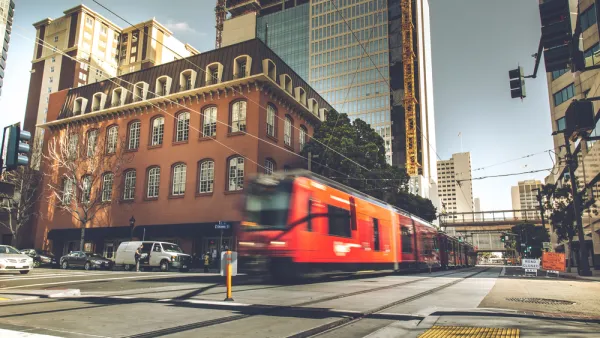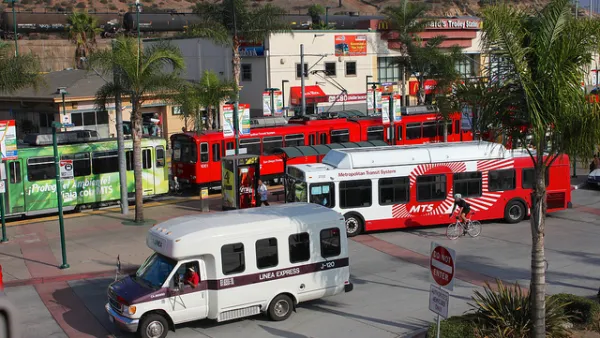In 2021, San Diego will open a northern trolley extension connecting its downtown and Golden Triangle. However, much of the route in between is barren and inaccessible. AIA-SD urges density and more effort to win over opponents.
In 2021, San Diego's light rail "trolley" system will open a northern leg, called the "Mid Coast Corridor." It will connect La Jolla, the Golden Triangle, UCSD, the V.A. Hospital, the city's Bio-Med industry, and neighborhoods in between, to downtown, the border, and the rest of the trolley system. Needless to say, its a critical corridor in the city's transit infrastructure. Finally, the coastal city and surrounding communities will have a light rail transit system with a hub downtown that goes in the core directions of north, south, and east.
Unfortunately, a large portion of the extension uses existing heavy rail right-of-way, runs adjacent and parallel to I-5, and borders urbanized areas on only one side—at the bottom of a steep hill that runs much of the length of the extension. Such is the reality of building light rail late in urban development. Moreover, the urbanized areas abutting the extension are low density and car oriented. Much of the middle portion of the extension is not very accessible, particularly to pedestrians and bicyclists.
These conditions were to be partially remedied by "The Morena Corridor Specific Plan," which was to facilitate transit oriented development. In 2014, a neighborhood backlash against lifting a 30-foot height limit to allow six-story transit oriented development near a station along the line scuttled the Specific Plan. In an open letter, AIA San Diego revisits the necessity of facilitating transit oriented development along the extension:
All communities must share responsibility for meeting housing and transportation infrastructure needs for the greater good of the region. Adding housing, creating transportation nodes, fostering retail & commercial services and committing to expanded public amenities enhances neighborhoods, making them better places to live, work, study, play and raise families. Increased density at Tecolote and other stations along the Corridor and throughout the region will create livable communities for the workforce that makes the city function – teachers, police, nurses, mechanics, chefs and servers, designers and many others. This approach fosters prosperity, prepares us for the exciting future promised by emerging transportation and energy technologies, and builds resilience against the environmental challenges that we will experience soon.
AIA-SD urges reconsideration and adoption of the Specific Plan:
We support our public officials, the Morena Corridor Specific Plan, and local developers that advocate for thoughtful, effective growth, and economic development of our neighborhoods.
For the the full letter from AIA, see the source article.
FULL STORY: Support the Morena Corridor Specific Plan

Analysis: Cybertruck Fatality Rate Far Exceeds That of Ford Pinto
The Tesla Cybertruck was recalled seven times last year.

National Parks Layoffs Will Cause Communities to Lose Billions
Thousands of essential park workers were laid off this week, just before the busy spring break season.

Retro-silient?: America’s First “Eco-burb,” The Woodlands Turns 50
A master-planned community north of Houston offers lessons on green infrastructure and resilient design, but falls short of its founder’s lofty affordability and walkability goals.

Test News Post 1
This is a summary

Analysis: Cybertruck Fatality Rate Far Exceeds That of Ford Pinto
The Tesla Cybertruck was recalled seven times last year.

Test News Headline 46
Test for the image on the front page.
Urban Design for Planners 1: Software Tools
This six-course series explores essential urban design concepts using open source software and equips planners with the tools they need to participate fully in the urban design process.
Planning for Universal Design
Learn the tools for implementing Universal Design in planning regulations.
EMC Planning Group, Inc.
Planetizen
Planetizen
Mpact (formerly Rail~Volution)
Great Falls Development Authority, Inc.
HUDs Office of Policy Development and Research
NYU Wagner Graduate School of Public Service



























